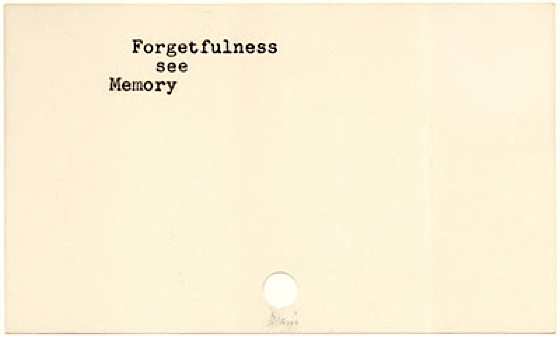Mere alphabetic adjacency

Tan Lin turned me on to the work David Bunn, who some years ago took possession of the entire Los Angeles public library’s card catalogue. Tan had noticed my interest in Erica Baum’s word-centered photography of old catalogues, and suggested I get to know Bunn's project.
Leah Ollman wrote an article for Art in America on Bunn in 2000, and here are two passages:
As libraries replace their card catalogues with on-line databases, the cards themselves--obsolete, bulky, worn--are usually discarded. Artist David Bunn rescued two million such cards and, in his elegant installations, directs our attention to the strong poetic voice still coursing through them. In 1990, David Bunn took possession of the two million cards in the Los Angeles Central Library’s catalogue somewhat in the manner of an eccentric heir claiming the unwanted portion of an estate. To administrators at the library, the card catalogue was not so much an inheritance as the deceased itself. Its contents had been made available on-line several years earlier, and it sat, an unwieldy, inconvenient corpse, awaiting suitable disposal. Why fill a storeroom with information that can now be saved on a chip the size of a postage stamp?
And later in the same article:
Strains of both Dada and Duchamp course through these found objects rendered into found poems. Mere alphabetic adjacency is the operative force, making close neighbors of utter strangers and catalyzing all sorts of disarming associations. Some of the poems are more like quips — “Sometimes a great notion/ sometimes a hero/sometimes a little brain damage can help” (1996)— while others offer swatches of casual beauty: “The sea is a magic carpet/the sea is also a garden/the sea is for sailing/the sea is for sailing/the sea is strong” (1997). The multiplicity of meanings and contexts for a single word, the very thing that stymies subject-driven computer searches and causes them to produce a cumbersome load of search matches, is what makes these snippets blossom on the page.
The poems often read as lists, oral recitatives drummed into memory, the rhythm of repetition building density, layer upon layer:
And the band played on / and the bride wore ... / and the bridge is love / and the children came too/ and the dawn came up like thunder / and the desert shall rejoice / and the doctor recovered/and the floods came / ... and the flowers showered/and the morrow is theirs/"and the next object ..." / and the river flowed on/and the sound of a voice ... / and the third day ... / “and the two shall become one flesh” /and the walls came tumbling down / and the years roll by.
The catalogue enables Bunn to narrate what he calls “a whole constellation of stories,” some focused on a particular moment in time or a brief thread of plot, others conjuring the grand, seamless narrative of existence, without beginning or end, shape or evident purpose.